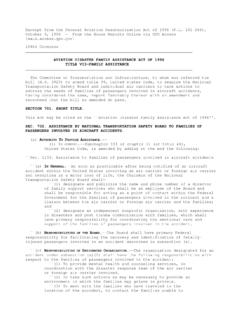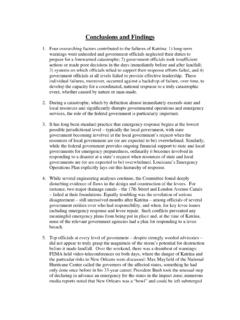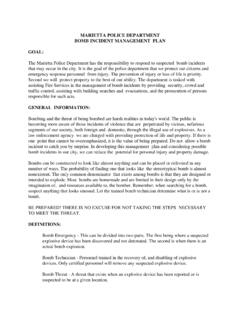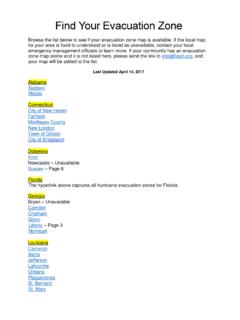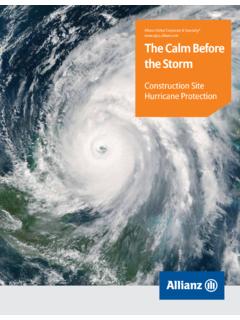Transcription of ACP Katrina Responses - Emergency management
1 Association of Contingency Planners (ACP) hurricane Katrina Observations NOAA via Getty Images Association of Contingency Planners Observations of hurricane Katrina Lessons Learned January 31, 2006 Prepared by: Paul Striedl, ACP CEO Jim Crosson, ACP Director of Chapter Services Leah Farr, ACP Director of Public Relations Page 1 of 14 Association of Contingency Planners (ACP) hurricane Katrina Observations The Association of Contingency Planners (ACP) is a non-profit trade association dedicated to fostering continued professional growth and development in effective Business Continuity and Continuity of Operations Planning. ACP is the recognized premier international networking and information exchange organization in the business continuity industry.
2 As practitioners and subject matter experts in the business continuity / continuity of operations profession, ACP members have a unique perspective on hurricane Katrina . Considering that ACP is the largest networking organization of contingency planners, ACP polled their member s intellectual capital to gather observations of the preparation and response measures to this unprecedented catastrophe. Identifying the lessons learned, whether in the public or private sector, enables the critical reevaluation of existing continuity plans to ensure the same mistakes are not made in the next disaster. While it is easy to be the arm chair quarterback in this situation, the purpose of this document is not to critique certain organizations and individuals, but rather to share information on ways to mitigate losses, both business and personal, to respond better, quicker, faster and even to identify measures that might save lives.
3 While no one organization or individual can ever mitigate all the losses or fix every problem, ACP can document and share lessons learned, and provide solutions to minimize risk and potential negative impacts. Page 2 of 14 Association of Contingency Planners (ACP) hurricane Katrina Observations The ACP Corporate Board of Directors would like to thank the following members for their contributions to this document: ACP Oklahoma Chapter Armour, Mark Atkinson, T. Scott Brown-Paul, Brenda Casey, Stephanie Cross, Raymond Dupree, Greg Fei, Angie Gray, Dorothy Haber, Jonathan Hayes, C. David Ju, Rockzann Kennedy, Linda Koempel, Matthews, Brenda May, Frank Middleton, Kelly Montgomery, Rob Palmisano, Robert Paul Peterson, Steven Ponciano, Manuel Price, Ty Rolfs, Scott Slutter, Dana Vanderploeg, Leon Page 3 of 14 Association of Contingency Planners (ACP) hurricane Katrina Observations Introduction [1] hurricane Katrina was the first Saffir-Simpson hurricane Scale Category 5 hurricane of the 2005 Atlantic hurricane season.
4 The storm made landfall as a Category 1 hurricane near Miami, Florida on August 25, 2005, then again as a Category 4 storm on August 29 along the Central Gulf Coast near New Orleans, Louisiana, Katrina resulted in breaches of the levee system that protected New Orleans from Lake Pontchartrain, and most of the city was subsequently flooded by the lake's waters. This and other major damage to the coastal regions of Louisiana, Mississippi, and Alabama made Katrina the most destructive and costliest natural disaster in the history of the United States. In Louisiana, the hurricane 's eye made landfall at 6:10am CDT on Monday, August 29. After 11:00am CDT, several sections of the levee system in New Orleans collapsed. Mandatory evacuation of New Orleans had been ordered by the mayor before the hurricane struck, on August 28.
5 The order was repeated on August 31. By early September, people were being evacuated, to neighboring states. The federal government of the United States issued disaster declarations blanketing 90,000 square miles of the United States. The hurricane left an estimated five million people without power, with time estimates for total restoration exceeding two months. The official death toll has surpassed 1,200 and the damage estimates have surpassed $200 billion. This tops hurricane Andrew as the most expensive natural disaster in history. Over a million people were displaced. hurricane Katrina created a humanitarian crisis on a scale unseen in the history of the 1 Wikipedia ( ) Page 4 of 14 Association of Contingency Planners (ACP) hurricane Katrina Observations Lessons Learned "In preparing for battle I have found that plans are useless, but planning is indispensable.
6 " Dwight D. Eisenhower The observations from hurricane Katrina are almost too numerous to list and continue to grow as the recovery efforts evolve over time. Instead of trying to identify every specific, the information was condensed into five, very general, categories. Most of this document s content has been gleaned from interpretations of the response at a local, state and federal level. In addition, being business continuity subject matter experts for companies directly impacted by this disaster, first-hand knowledge of their response as well as that of their vendors and business partners was identified. 1. There is no substitute for thorough preparation In an industry devoted to preparation, this should go without saying. Yet, how many of the plans developed and implemented deal with Emergency response and recovery?
7 How much time has been spent working on evacuations and shelter-in-place procedures? What types of supplies are on-hand? When faced with evident threats, how quick are these steps put into play? Are these plans ever put into motion? How prepared are we as individuals? Do tight budgets come into the decision making process when deciding to evacuate? Here are some things to consider: Command and Control can be argued as the single most important aspect of business continuity and disaster recovery. Never has this been so clearly demonstrated than it was with the apparent lack of coordination at all levels during the hurricane Katrina event. The Command and Control Plan outlines the chains of command, identifies who the specific commanders are, as well as their backups, and how they can or cannot transfer that command, what are the specific roles & responsibilities, and should state that higher level executives should not be able to usurp authority from designated commanders.
8 The commanders run the event, the executives run the business and there should be no interference. During hurricane Katrina , the breakdown was between Local, State, and Federal commanders who did not want to relinquish control, the transfer of control is defined in the laws governing Emergency situations in the State and Federal arenas and was not properly executed during the event. Thorough Preparation Lesson 1 Improve and enhance disaster preparation and crisis response plans through worst-case scenario testing and exercising. Page 5 of 14 Association of Contingency Planners (ACP) hurricane Katrina Observations Thorough Preparation Lesson 2 Clearly define your organization s command and control organizational structure for emergencies.
9 Include procedure for linking to local Emergency management and response agencies. Businesses need to take planning and preparation seriously prior to events such as hurricane Katrina . Chains of command and decision-making can never break down under such circumstances and having a comprehensive and reliable document to turn to is essential. This makes promotion, education and testing important tools in the preparation process. Make sure decision-makers not only understand their role, but are properly versed in how to access and implement the plans that you ve worked so diligently to complete. Thorough Preparation Lesson 3 Regularly exercise your command and control organization as part of a comprehensive business continuity and continuity of operations exercise strategy.
10 How well New Orleans and nearby areas did in preparing and evacuating their citizens remains to be seen and will continue to be a topic of debate. Leaders were too late in ordering a mandatory evacuation. Unfortunately, more could have been done to ensure those without the means had the resources to leave. Government agencies at all levels need to take a hard look at their Emergency response procedures. Exactly who was in charge and who was responsible for making the tough decisions seemed unclear in the days prior to and immediately following the storm. Both local and state governments need to have a thorough understanding of the resources available to them. Additionally, leaders must learn how to marshal their forces when necessary and understand the most expedient ways to reach affected individuals.

